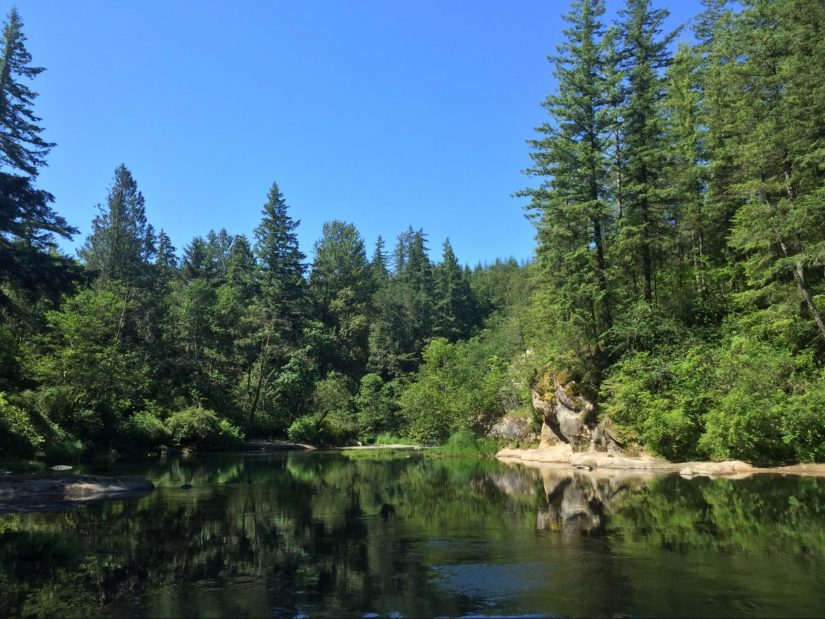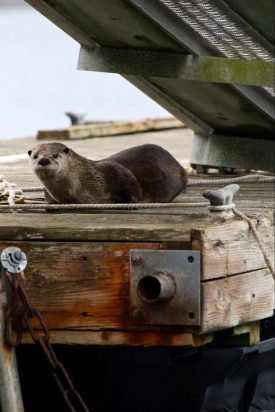Lessons From River Otters
The Green River bubbles to life high up in the Cascade Mountains of Washington State and flows northwest. It empties into Puget Sound as the Duwamish River, just south of downtown Seattle. Although I grew up less than twenty minutes away, I never spent any real time on the Duwamish River, nor did I have any sense of its history. That changed five years ago, when I found myself involved in the Duwamish clean-up effort in an unlikely way. In 2016, Michelle Wainstein – at the time a field conservation associate at the Woodland Park Zoo – began the first contamination study of river otters in the Green-Duwamish River; I was her summer intern.
***
Over 150 years ago, the first white settlers arrived to stake land claims at the mouth of the Duwamish River, the home of the Duwamish Tribe. Development, settler-colonial land grabs, and violence followed as the city of Seattle grew. Between 1913 and 1920, the Duwamish Waterway Commission dredged and straightened the last five miles of the winding Green-Duwamish River into the Lower Duwamish Waterway. The Lower Duwamish would not only become the hub of Seattle’s modern industry, but also its toxic dumpster. Untreated sewage, stormwater runoff, and industrial waste flowed unabated into the waterway for decades, spurred by the influx of commercial development starting in 1917 led by companies like Boeing, a pioneer in technological and scientific advancement.
“The Lower Duwamish would not only become the hub of Seattle’s modern industry, but also its toxic dumpster.”

Nearly a century later, in 2001, the waterway was designated a Superfund Site. Superfund Sites are the most contaminated places in the country as designated by the Environmental Protection Agency (EPA), posing hazards to both human and natural communities. The primary contaminants found in the ecosystem include heavy metals such as arsenic and lead as well as chemicals used in industrial activities and building materials (e.g. polychlorinated biphenyls or PCBs). The entities found ultimately responsible for polluting the river system are now paying to clean it up, with some investing significant resources into remediation, including Boeing, the City of Seattle, and King County.
The toxins found in the waterway pose a risk to local communities in many ways, including consumption of fish and shellfish and exposure through contact with contaminated sediments at parks and beaches. The two riverside neighborhoods, South Park and Georgetown, are among Seattle’s lowest income and most ethnically and racially diverse neighborhoods, making the disproportionate exposure to environmental and health hazards one of Seattle’s biggest environmental justice issues. The negative health impacts of toxins like PCBs increase in severity as they build up over time and are transferred up the food chain. This process of biomagnification is dangerous for humans and animals ingesting contaminated plants, shellfish, and fish.
Michelle’s project aimed to study pollutants in otter poop, known as “scat,” in an attempt to measure contamination levels throughout the river system. As opportunistic predators at the top of the food chain, river otters eat everything from shellfish to small mammals, making them vulnerable to biomagnification. As such, in polluted systems like the Duwamish, they are considered to be potential biomonitors of toxic build up in wildlife and overall environmental health. The goal was to gain a sense of the extent and magnitude of the contamination within river otters by sampling scat from sites spread from the Lower Duwamish Waterway to the upper sections of the Green River.
“As opportunistic predators at the top of the food chain, river otters eat everything from shellfish to small mammals, making them vulnerable to biomagnification.”
Although you may never see them due to their elusive nature, there is a robust river otter population within the urban expanses of the Greater Seattle area. Little is known about these otters, including the very basics like population size or distribution. But if you know what to look for, you’ll start to see signs of the feisty creatures everywhere. River otter society is organized around communal bathrooms, also known as latrines – which in urban settings like Seattle, are found anywhere from private docks to popular waterside parks. These public toilets are epicenters of communication, where an otter can deposit its scent for others to find through scat, urine, and anal excretions. Otter scat has a surprisingly distinct putrid, fishy smell. Smell it once and you can recognize it anywhere. The color can range from dark brown to burnt orange to deep green, depending on what the otter has eaten that day. Due to their incredibly fast digestive systems, otter scat unfailingly contains remnants of their diets. In my explorations, I have found everything from fully intact crayfish claws to fish vertebrae.
A river otter performing the “scat dance” as caught on one of our game cameras. Video Credit: Michelle Wainstein, shared with permission.
Otters generally select latrine locations based on easy exit and entry to a water body, making it relatively easy to predict where these latrines might be. For three months Michelle and I bushwhacked through blackberry brambles, scouted the docks of urban marinas, and scooped smelly samples into little glass jars. It was a summer of monotonous beauty, until one specific day in July wrenched me out of my stinky, sunburnt daze.
***
After sitting in morning traffic on Highway 99, we drove about an hour southeast of Seattle to a sampling site in the Green River Natural Area. By that point in the summer, we had memorized the route from car to latrine. We had walked it nearly everyday for weeks in our search for fresh scat – the sample had to be at most 24 hours old for reliable lab results. Leaving the red Prius parked by the side of the road, we set off down the old dirt path, overrun with weeds and molding coyote droppings, toward a small meadow. Dampened with dew, waist-high blades of grass painted our pants as the path narrowed into a meandering fisherman’s trail to the river. Every so often we’d stop to detach ourselves from the brambles that snagged our clothes, but for most of the walk we strode quietly, listening to the symphony of bird calls in the canopy above.
As we neared the river, the trail spilled out into a wooded glen. Sun streamed through the gaps in the canopy, enveloping the grasses at our feet in a gentle morning glow. Staying straight, we carefully passed the underground wasp nest that we discovered the week before, ducked under one last blackberry cluster extended across the path, and exited out onto the bank of the river. There was only one thing on our mind as we approached the riverbank: fresh scat. It is actually quite an arduous process to find it. Otters do not necessarily use the same latrine everyday. There were many days, weeks even, when there was no fresh scat at any of our identified latrines. But as we approached, I could smell that fresh, fishy odor.

I counted five new scats perched on the bulbous nests of grass that otters craft before doing their business. I then set to work meticulously swabbing, collecting, and labeling the various samples. After cataloging the last sample, I stood up to stretch my back and glanced over toward the river. To my surprise, there was a tiny otter pup staring right at me, frozen only a few feet away where the rocky shore met the river, its sleek fur glistening in the sun. Its black eyes were wide and its whiskers twitched. It chirped as if to ask what these strange creatures were doing in its bathroom. The interaction lasted no more than twenty seconds before the otter slipped smoothly, silently back into the river and swam upstream, invisible under the surface except for a trail of bubbles that marked its progress.
As the excitement of seeing my very first wild otter wore off, I began to experience a very different feeling, something uneasy, akin to guilt or anxiety. I immediately wanted to apologize, run the other direction, and never return in fear of disturbing the pup’s restroom routine again. We had not seen an otter all summer until that day. This could be explained by the fact that they are naturally elusive animals and are most active at night. However, I cannot help but think that we never saw them because we were not supposed to see them. My encounter with this tiny otter was a fluke, a result of its infantile innocence and curiosity.
***
That encounter prompted me to reflect on my previously held beliefs on the role and presence of scientists in natural settings. Although our research was considered to be “noninvasive,” since we were not physically handling animals, the most apt way to describe how I felt that morning was, in fact, invasive. Who really knows what impact our presence in those latrines had on the otters. It is possible that our foreign smells entirely disrupted their complex system of communication. At the same time, I asked myself, what if we were not doing this research? Realistically, our work collecting otter scat was important in understanding the extent of persisting pollution in the Green-Duwamish River – at the same time, we were only there because of the actions of our fellow humans. I felt as though I had been caught up in some unending cycle of continued human interference.
A year later, Michelle emailed me the report she wrote for the Washington Department of Fish and Wildlife. The sampling results showed a clear correlation between PCB concentration in river otter latrine sites in the upper and lower river. Scat from within the Superfund Site itself was far more contaminated than scat from elsewhere along the river, far exceeding the threshold value at which PCB contamination is known to cause adverse effects in river otters. Our efforts confirmed that otters may be useful biomonitors for the level of PCBs in the Green-Duwamish River. Michelle’s study has important implications for continuing to monitor pollutant concentrations along the river and remains the only empirical study on contaminants in mammals or apex predators in the Green-Duwamish River. It also resulted in the creation of a website through which citizens can report their sightings of river otters as a part of the “Carnivore Spotter” program, which serves to increase knowledge of the distribution of otter populations in the Puget Sound area. There is now more information about river otters within the Green-Duwamish ecosystem than ever before. But, I still grapple with feeling proud of my contribution to an important project while, at the same time, feeling immensely guilty for invading a space that was never mine.
“Michelle’s study has important implications for continuing to monitor pollutant concentrations along the river into the future and remains the only empirical study on contaminants in mammals or apex predators in the Green-Duwamish River.”

We still have much to learn about the ecosystems in our backyards, and the story of the Green-Duwamish River is unfinished. While many restoration projects along the river are ongoing, environmental groups sued Boeing in 2018 alleging continued discharge of toxic PCBs into the waterway at levels far above the legal limit, further endangering local communities and wildlife. Two years later in 2020, Boeing settled, ultimately agreeing to pay $750,000 and take further action to mitigate contaminated runoff from its facilities. The trajectory of the Duwamish Waterway clean-up is by no means straightforward and in 2022 we are still watching it play out.
“Many Seattlites may not even realize there are river otters living amongst us, yet they can tell us a lot about the health of the places in which we live, work, and play.”
As Seattle’s only river, the Duwamish simultaneously supports industry, residential communities, and many species of wildlife including salmon, water birds, and of course, river otters. Although they may not be the flashiest of apex predators in the Northwest – I think we are more likely to conjure images of cougars, wolves, and bears – river otters have a lot to teach us. In searching for insights about our environment, it is not always the most obvious sources that have the most to say. By measuring contaminant levels in otters, we can gain an understanding of how toxins work their way through the food chain and get into the bodies of mammals. Many Seattlites may not even realize there are river otters living amongst us, yet they can tell us a lot about the health of the places in which we live, work, and play.